Cost Estimation Tool for Metallic Parts Made by Casting: A Case Study
Abstract
1. Introduction
- To generate budgets that avoid over or under-quoting that can result in the loss of company clients or even assume losses that endanger the viability of the company.
- To track the progress of external (labour rate, energy price and raw material cost) and internal factors (yield, recycling, rejection, and tools/methods used) and to evaluate their effect on the cost of the casting.
- To identify the drivers that might have a high impact on the cost reduction.
- Analogical techniques employ similarity with products found on historical databases by assuming that similar products have similar costs. They select certain variables, and a linear relationship is established between the product and the cost. These relations are then used to forecast the cost of the new product [9].
- Parametric methods apply statistical calculations by expressing cost as a function of its constituent variables. For this approach to be effective, the cost drivers have to be identified and the variance of data must be taken into account [7].
- In the bottom-up technique, estimation of the product is decomposed into the elementary tasks, operations and/or activities needed to perform the work. The costs involved in the process have to be characterised and classified and are usually known or easily calculated by means of algorithms and equations as they relate to the item’s attributes, such as roughness or maximum thickness [10].
2. Results and Discussion
2.1. Metal Casting Cost Drivers Assessment
2.1.1. Pre-Casting
2.1.2. Casting
2.1.3. Post-Casting
- Heat treatments (HT)
- Finishing
2.2. Mathematical Expressions for Calculating the Cost
2.2.1. Material
2.2.2. Labour
2.2.3. Energy
- ➢
- Cheat treatments = the cost of the heat treatments:
- ➢
- Cmachining is the energy required for machining the metallic part:
- ➢
- Cother energy = the cost of the other energy used for running the plant
2.2.4. Tooling
- ➢
- Cupdates = cost of software updates
- ➢
- Cconsumables = the cost associated to consumables for the use of tooling in MAD
- ➢
- Cmaintenance = the cost of the equipment maintenance in MAD
- ➢
- Cmachining = the cost of machining in MAD per part **
2.2.5. Overheads
- ➢
- Cadministration = the administration of the whole business in % of the cast part cost.
- ➢
- Cdepreciation = the depreciation cost of the entire plant in % of the cast part cost.
2.3. Case Study: Casting a Radial Pump in Morocco
2.3.1. Cost Estimation Input for Metal Casting
Material
- Very-high price (50-year average ~$1000/mole): Au, Sc and platinum group metals (Ru, Os, Rh, Ir, Pd and Pt).
- High price (50-year average ~$100/mole): Ag, Ga, Ge, Hf, In, La, Ta.
- Intermediate price (50-year average ~$5/mole): Be, Bi, Cd, Co, Mo, Nb, Sn, Te, W, Y and Zr.
- Low price (50-year average ~$0.5/mole): Al, Cr, Cu, Fe, Li, Mg, Mn, Ni, Pb, Sb, Si, Ti, V and Zn.
Labour
- 0.5 × 0.5 × 0.5 m3
- 0.5 × 0.5 × 1 m3
- 0.75 × 0.75 × 0.5 m3
- 1 × 1 × 0.5 m3
- 1 × 1 × 1 m3
Energy
Tooling
Overheads
3. Final Cost and Remarks
- To store raw material that is difficult to find and whose price fluctuates suddenly when its value is optimum.
- To reduce manpower by installing automated equipment.
- To organise production to save some energy by keeping the furnaces on during low-cost time slots and during the shortest possible time.
4. Conclusions
Author Contributions
Funding
Data Availability Statement
Acknowledgments
Conflicts of Interest
Nomenclature
| MAD | Moroccan dirham |
| INR | Indian rupee |
| USD | United States Dollar |
| PCE | Product cost estimation |
| HT | Heat treatments |
| Ctotal | Total cost |
| Cmaterial | Cost of the material |
| Cdirect | Direct material cost |
| Cindirect | Indirect material cost |
| Pmetal | Price of the metal used |
| Wcast | Weight of the cast part |
| fm | Metal loss factor during melting |
| fp | Metal loss factor during pouring |
| Cmould sand | Mould sand mixture cost |
| Ccore sand | Core sand mixture cost |
| Cmiscellaneous | Miscellaneous materials cost |
| Pmould sand | Price of mould sand mixture |
| frecycle | Sand recycling factor |
| fr | Casting rejection factor |
| fmould rej | Mould rejection factor |
| Wmould sand | Weight of sand mould |
| ρmould sand | Mould sand density |
| Vmould sand | Total volume of the mould sand |
| Vflask | Volume of the flask |
| Vcast | Volume of the cast part |
| Vgating | Volume of the entire gating system |
| Vfeeder | Volume of feeders |
| Vcore | Volume of the core(s) |
| Pcore sand | Price of core sand mixture |
| Wcore sand | Weight of sand mould |
| ρcore sand | Core sand density |
| Vcore sand | Total volume of the core sand |
| fcore rej | Core rejection factor |
| Cwood | Wood cost for pattern |
| Pwood | Price of wood |
| Vwood | Volume of wood used to produce the pattern |
| Clabour | Cost of the labour |
| Clabour highly qualified | Highly qualified labour cost |
| Clabour technical | Technical labour cost |
| fr | Factor for casting rejection |
| m | Number of designs |
| fdesign rejection | Rejection factor for the design |
| Shigh qualification | Salary per hour of the highly qualified worker |
| ldesignHQ | Number of highly qualified workers involved in the design |
| tdesign | Time spent in the design |
| nparts | Number of parts produced from the design/activity |
| factivity rejection | Rejection factor for activity i |
| n | Number of activities |
| Stechnical | Salary per hour of the technician |
| lactivity | Number of technicians involved in certain activity |
| tactivity | Time spent in certain activity |
| Cenergy | Cost of the energy |
| Cmelting | Cost of the melting process |
| Cholding | Cost of holding the material at a certain temperature |
| Cheat treatments | Cost of the heat treatments |
| Cmachining | Energy required for machining the metallic part |
| Cother energy | Cost of the other energy used for running the plant |
| Penergy | Price of the energy |
| Emelting | Energy required by the electric arc furnace for melting the metal |
| Wmetal | Weight of metal needed |
| tholding | Time that the holding process takes |
| Eholding | Energy required to keep the temperature of the melt constant during holding time |
| Cstress relieving | Cost of the stress relieving process |
| Estress relieving | Energy required for stress relieving |
| Cannealing | Cost of the annealing process |
| Eannealing | Energy required for annealing |
| Cpreheating and cooling | Cost of the preheating and cooling processes |
| Epreheating and cooling | Energy required for preheating and cooling |
| Cmachining pp | Cost of the machining process per part |
| Emachining | Energy required to machine a part |
| tmachining | Time required to machine the part |
| Ctooling | Cost of the tooling |
| Cupdates | Cost of software updates |
| Cconsumables | Cost associated to consumables for the use of tooling |
| Cmaintenance | Cost of the equipment maintenance |
| nup | Number of updates |
| Pupdates | Price of software updates |
| nx | Amount of design, machined parts, etc. produced |
| Coverheads | Cost of the overheads |
| Cadministration | Administration of the whole business |
| Cdepreciation | Depreciation cost of the entire plant |
References
- Callister, W.D.; Rethwisch, D.G. Materials Science and Enginnering an Introduction, 8th ed.; John Wiley & Sons, Inc.: Hoboken, NJ, USA, 2010. [Google Scholar]
- Campbell, J. Complete Casting Handbook: Metal Casting Processes, Techniques and Design, 2nd ed.; Elsevier Ltd.: Oxford, UK, 2011. [Google Scholar]
- Hawaldar, N.; Zhang, J. A comparative study of fabrication of sand casting mold using additive manufacturing and conventional process. Int. J. Adv. Manuf. Technol. 2018, 97, 1037–1045. [Google Scholar] [CrossRef]
- Ben-Arieh, D.; Qian, L. Activity-based cost management for design and development stage. Int. J. Prod. Econ. 2003, 83, 169–183. [Google Scholar] [CrossRef]
- Wasim, A.; Shehab, E.; Abdalla, H.; Al-Ashaab, A.; Sulowski, R.; Alam, R. An innovative cost modelling system to support lean product and process development. Int. J. Adv. Manuf. Technol. 2012, 65, 165–181. [Google Scholar] [CrossRef]
- Ravi, B.; Chougule, R.G. Concepts on Cost Modeling and Reduction in Foundry Industry. In Proceedings of the National Convention on Cost Cutting and Advancements in Forging, Sheet Metal Forming & Fastners and Modern Foundry Techniques, Mumbai, India, February 2005. [Google Scholar]
- Niazi, A.; Dai, J.S.; Balabani, S.; Seneviratne, L. Product Cost Estimation: Technique Classification and Methodology Review. J. Manuf. Sci. Eng. 2005, 128, 563–575. [Google Scholar] [CrossRef]
- Hueber, C.; Horejsi, K.; Schledjewski, R. Review of cost estimation: Methods and models for aerospace composite manufacturing. Adv. Manuf. Polym. Compos. Sci. 2016, 2, 1–13. [Google Scholar] [CrossRef]
- Huang, X.X.; Newnes, L.; Parry, G.C. The adaptation of product cost estimation techniques to estimate the cost of service. Int. J. Comput. Integr. Manuf. 2012, 25, 417–431. [Google Scholar] [CrossRef]
- Favi, C.; Germani, M.; Mandolini, M. Analytical Cost Estimation Model in High Pressure Die Casting. Procedia Manuf. 2017, 11, 526–535. [Google Scholar] [CrossRef]
- Chougule, R.G.; Ravi, B. Casting cost estimation in an integrated product and process design environment. Int. J. Comput. Integr. Manuf. 2006, 19, 676–688. [Google Scholar] [CrossRef]
- Beddoes, J.; Bibby, M. Principles of Metal Manufacturing Processes; Elsevier Butterworth-Heinemann: Oxford, UK, 1999. [Google Scholar]
- Stefanescu, D.M. Metals Handbook-Vol 15 Casting; ASM International: Almere, The Netherlands, 1988. [Google Scholar]
- Kovačič, M.; Stopar, K.; Vertnik, R.; Šarler, B. Comprehensive Electric Arc Furnace Electric Energy Consumption Modeling: A Pilot Study. Energies 2019, 12, 2142. [Google Scholar] [CrossRef]
- Totten, G.O. Steel Heat Treatment: Metallurgy and Technologies, 2nd ed.; Taylor & Francis: Boca Raton, FL, USA, 2007. [Google Scholar]
- Liscic, B.; Tensi, H.M.; Canale, L.C.F.; Totten, G.E. Quenching Theory and Technology, 2nd ed.; Taylor & Francis: Boca Raton, FL, USA, 2010. [Google Scholar]
- Sonar, T.; Lomte, S.; Gogte, C. Cryogenic Treatment of Metal—A Review. Mater. Today: Proc. 2018, 5, 25219–25228. [Google Scholar] [CrossRef]
- Casteletti, L.C.; Neto, A.L.; Totten, G.E. Nitriding of Stainless Steels. Met. Microstruct. Anal. 2014, 3, 477–508. [Google Scholar] [CrossRef]
- Fu, X.; Schuh, C.A.; Olivetti, E.A. Materials selection considerations for high entropy alloys. Scr. Mater. 2017, 138, 145–150. [Google Scholar] [CrossRef]
- Desai, C.; Garala, K.; Doshi, K.; Mehta, Y.; Jha, E.; Patel, G.H. Rejection Analysis and Quality Control of Castings at Inducto Cast. Int. J. Eng. Res. Technol. 2020, 8, 910–918. Available online: www.ijert.org (accessed on 22 February 2021).
- Anwar, N.; Sappinen, T.; Jalava, K.; Orkas, J. Comparative experimental study of sand and binder for flowability and casting mold quality. Adv. Powder Technol. 2021, 32, 1902–1910. [Google Scholar] [CrossRef]
- Thaarrini, J.; Ramasamy, V. Properties of Foundry Sand, Ground Granulated Blast Furnace Slag and Bottom Ash Based Geopolymers under Ambient Conditions. Period. Polytech. Civ. Eng. 2016, 60, 159–168. [Google Scholar] [CrossRef]
- RecycleInMe. Current Cast Iron Prices—South Indian Scrap Prices. Available online: https://www.recycleinme.com/scrapresources/DetailedPrice?psect=1&cat=SouthIndianScrapPrices&subcat=CastIron (accessed on 31 December 2022).
- MEPS International. World Stainless Steel Prices. Available online: https://mepsinternational.com/gb/en/products/world-stainless-steel-prices (accessed on 31 December 2022).
- Metals-hub. The Most Reliable Metals Price Indices. Available online: https://www.metals-hub.com/data/ (accessed on 31 December 2022).
- Indiamart. Available online: https://dir.indiamart.com/impcat/pinewood.html (accessed on 31 December 2022).
- Duval, J.B. Foundry manual – Chap.5: Making molds; US government printing office: Washington, WA, USA, 1958.
- Kanthavel, K.; Arunkumar, K.; Vivek, S. Investigation of Chill Performance in Steel Casting Process Using Response Surface Methodology. Procedia Eng. 2014, 97, 329–337. [Google Scholar] [CrossRef]
- Siddique, R.; Kunal. Utilization of industrial by-products and natural ashes in mortar and concrete. In Nonconventional and Vernacular Construction Materials; Sharma, K.A., Harries, B., Eds.; Elsevier: Amsterdam, The Netherlands, 2016; pp. 159–204. [Google Scholar]
- Sihag, N.; Sangwan, K.S. A systematic literature review on machine tool energy consumption. J. Clean. Prod. 2020, 275, 123125. [Google Scholar] [CrossRef]
- Office National de l’Electricité, et de l’Eau Potable. Available online: http://www.onep.ma (accessed on 4 May 2021).
- Adams, W.; Alameddine, S.; Bowman, B.; Lugo, N.; Paege, S.; Stafford, P. Total energy consumption in arc furnaces. Metall. Plant Technol. Int. 2002, 25, 44–50. [Google Scholar]
- Electric Arc Furnace. 2010. Available online: http://www.iipinetwork.org/wp-content/Ietd/content/electric-arc-furnace.html (accessed on 14 March 2021).
- Gutowski, T.G.; Sekulic, D.P. Thermodynamic Analysis of Resources Used in Manufacturing Processes 1. In Thermodynamics and the Destruction of Resources; Bakshi, B.R., Gutowski, T.G., Sekulic, D.P., Eds.; No. 36; Cambridge University Press: Cambridge, UK, 2011; pp. 1–43. [Google Scholar]
- Heat Treat Technologies. Electric Arc Furnace: Energy Consumption. Available online: http://heattreatconsortium.com/metals-advisor/electric-arc-furnace/electric-arc-furnace-energy-consumption/#:~:text=Energyconsumptionvariesfrom350,consumptionto425kWh%2Fton (accessed on 7 September 2021).
- Heat Treating of Gray Irons: Part Two. 2003. Available online: https://www.totalmateria.com/page.aspx?ID=CheckArticle&site=kts&NM=115 (accessed on 3 January 2021).
- Kallen, M. Energy Efficiency Opportunities within the Heat Treatment Industry Energy Efficiency Opportunities within the Heat Industry. Master’s Thesis, Chalmers University of Technology, Göteborg, Sweden, 2012. [Google Scholar]
- Ortega-Cubillos, P.; Universidade Federal de Santa Catarina; Nannetti-Bernardini, P.A.; Celso-Fredel, M.; Campos, R.A. Wear resistance of high chromium white cast iron for coal grinding rolls. Rev. Fac. De Ing. 2015, 2015, 134–142. [Google Scholar] [CrossRef]
- Dahmus, J.B.; Gutowski, T.G. An Environmental Analysis of Machining. ASME Int. Mech. Eng. Congr. Expo. 2004, 47136, 643–652. [Google Scholar] [CrossRef]
- Moradnazhad, M.; Unver, H.O. Energy efficiency of machining operations: A review. Proc. Inst. Mech. Eng. Part B: J. Eng. Manuf. 2016, 231, 1871–1889. [Google Scholar] [CrossRef]
- Balogun, V.A.; Mativenga, P.T. Modelling of direct energy requirements in mechanical machining processes. J. Clean. Prod. 2013, 41, 179–186. [Google Scholar] [CrossRef]
- Rao, C.; Sreeamulu, D.; Mathew, A.T. Analysis of Tool Life during Turning Operation by Determining Optimal Process Parameters. Procedia Eng. 2014, 97, 241–250. [Google Scholar] [CrossRef]
- Castings, P.S. Activity-Based Cost Estimation Model for Foundry Systems Producing Steel Castings. Jordan J. Mech. Ind. Eng. 2012, 6, 75–86. [Google Scholar]
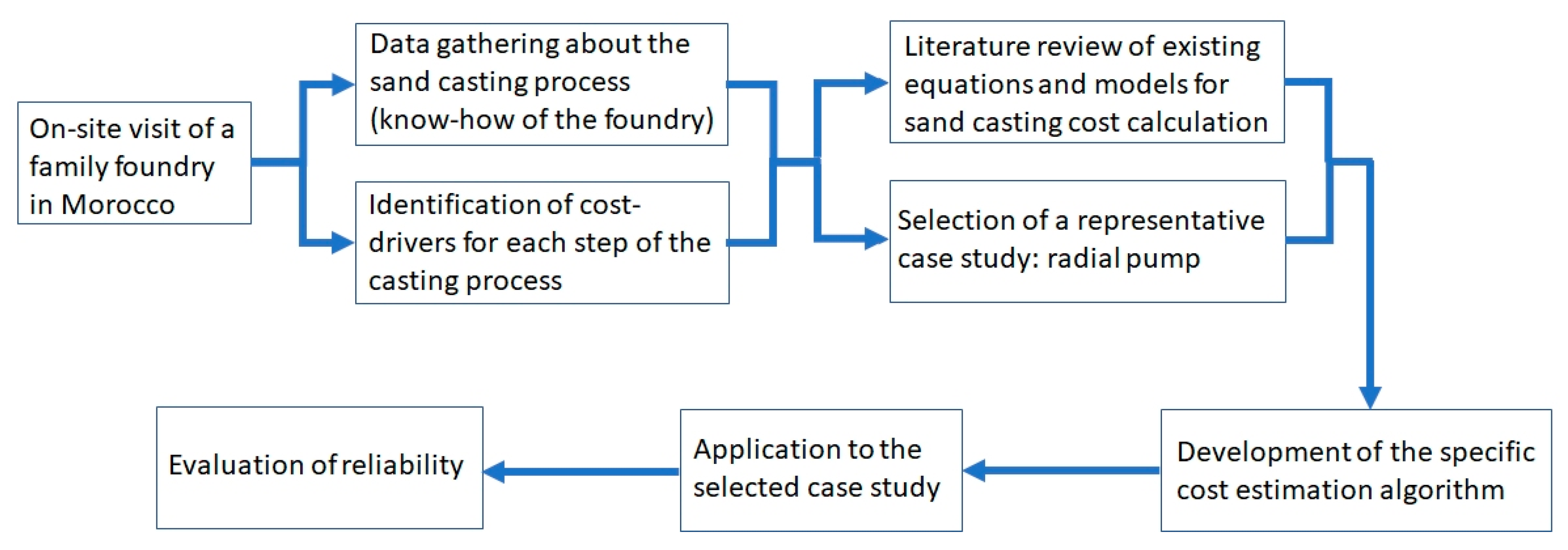
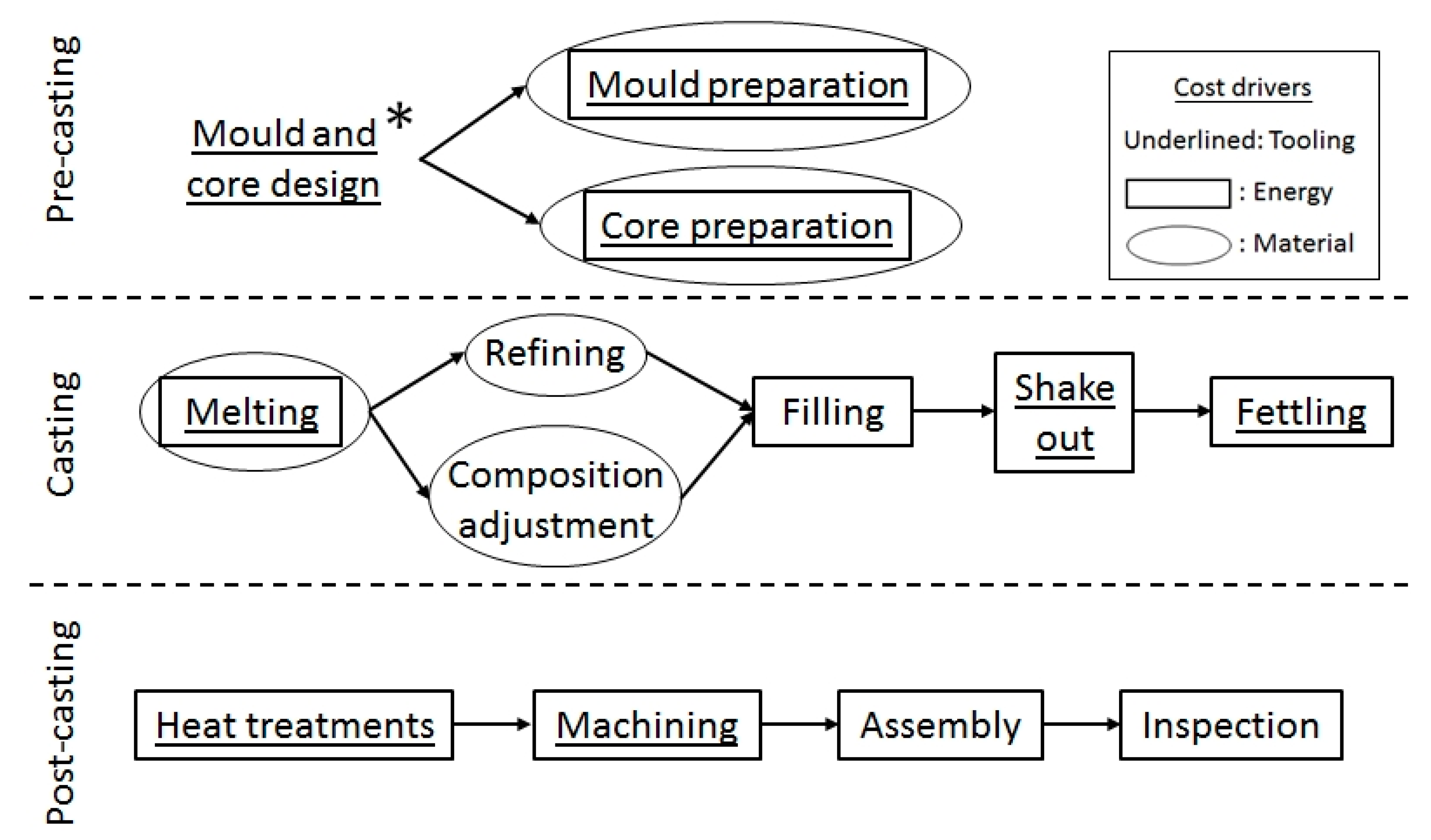
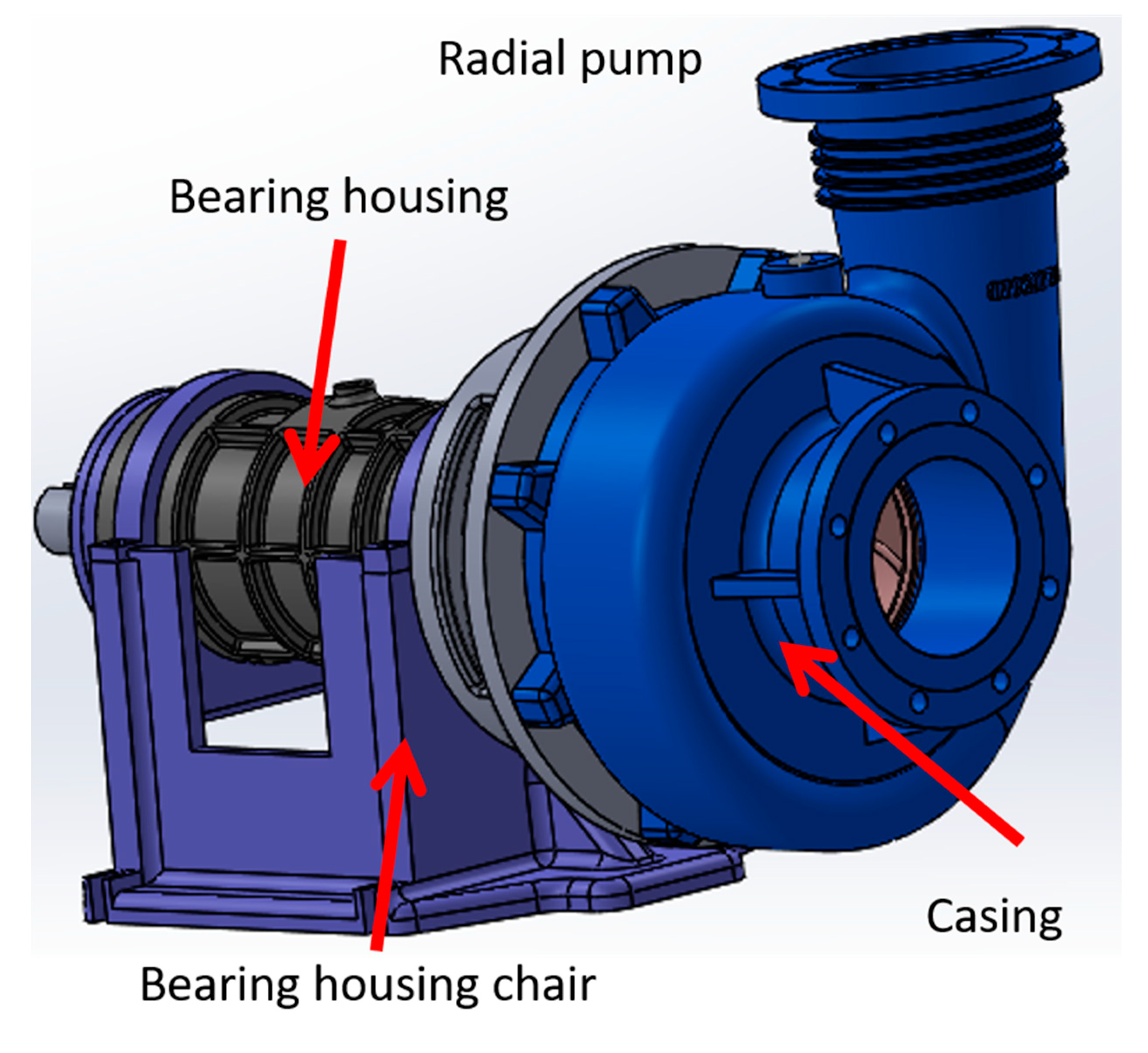
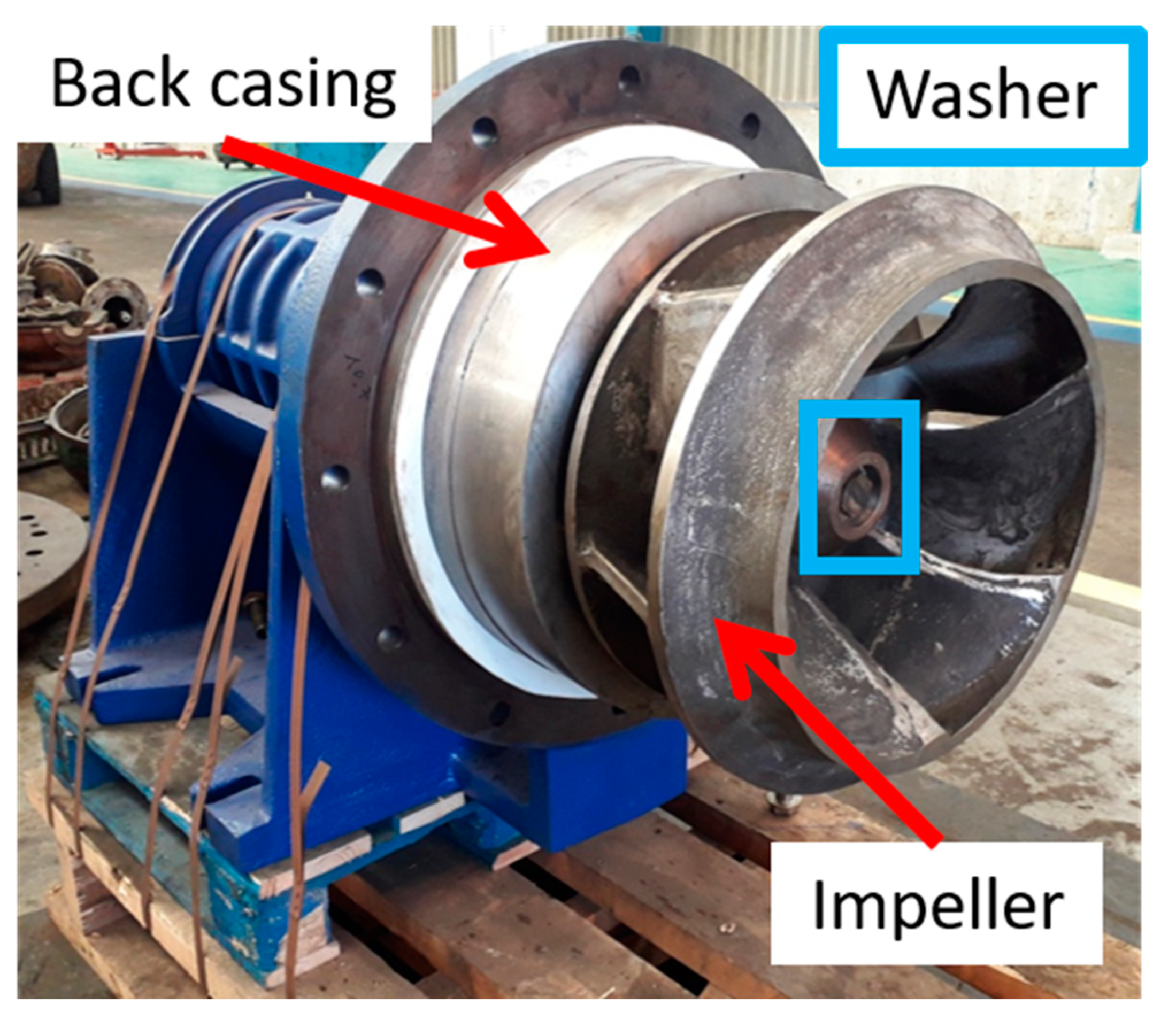
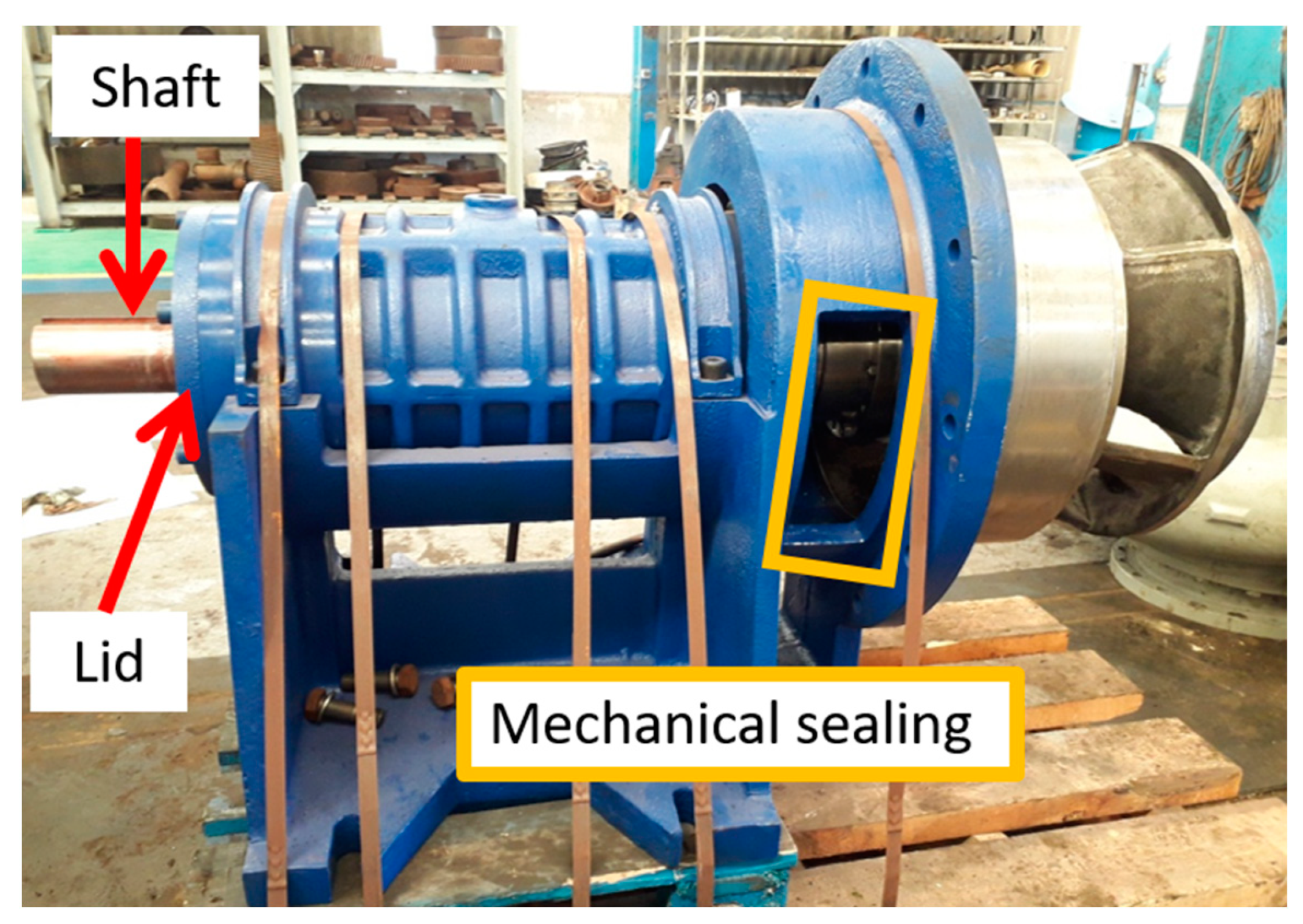


| Material | Price | Price MAD (Exchange Rate of 31 December 2022) | Reference |
|---|---|---|---|
| Scrap grey cast iron | 26–41.5 INR/kg | 3.28–5.236 MAD/kg | [23] (accessed December 2022) |
| 316L Stainless steel bar | 6148–7783 $/T | 64.21–81.29 MAD/kg | [24] (accessed December 2022) |
| FeCr (65% Cr min.) | 6.74–9.22 €/kg Cr | 75.37–103.09 MAD/kg Cr | [25] (accessed December 2022) |
| Mould sand | 1.2 INR/kg | 0.15 MAD/kg | [11] |
| Core sand | 3.0 INR/kg | 0.38 MAD/kg | [11] |
| Pine wood | 700–900 INR/ft3 | 3120–4012 MAD/m3 | [26] (accessed December 2022) |
| Material | Specific Energy Range (kJ) | Average Specific Energy (kWh) |
|---|---|---|
| Stainless steel | 250–625 | 0.1215 |
| Steel | 260–1150 | 0.1958 |
| Cast iron | 140–690 | 0.1152 |
Disclaimer/Publisher’s Note: The statements, opinions and data contained in all publications are solely those of the individual author(s) and contributor(s) and not of MDPI and/or the editor(s). MDPI and/or the editor(s) disclaim responsibility for any injury to people or property resulting from any ideas, methods, instructions or products referred to in the content. |
© 2023 by the authors. Licensee MDPI, Basel, Switzerland. This article is an open access article distributed under the terms and conditions of the Creative Commons Attribution (CC BY) license (https://creativecommons.org/licenses/by/4.0/).
Share and Cite
Iraola-Arregui, I.; Ben Youcef, H.; Trabadelo, V. Cost Estimation Tool for Metallic Parts Made by Casting: A Case Study. Metals 2023, 13, 216. https://doi.org/10.3390/met13020216
Iraola-Arregui I, Ben Youcef H, Trabadelo V. Cost Estimation Tool for Metallic Parts Made by Casting: A Case Study. Metals. 2023; 13(2):216. https://doi.org/10.3390/met13020216
Chicago/Turabian StyleIraola-Arregui, Itziar, Hicham Ben Youcef, and Vera Trabadelo. 2023. "Cost Estimation Tool for Metallic Parts Made by Casting: A Case Study" Metals 13, no. 2: 216. https://doi.org/10.3390/met13020216
APA StyleIraola-Arregui, I., Ben Youcef, H., & Trabadelo, V. (2023). Cost Estimation Tool for Metallic Parts Made by Casting: A Case Study. Metals, 13(2), 216. https://doi.org/10.3390/met13020216






